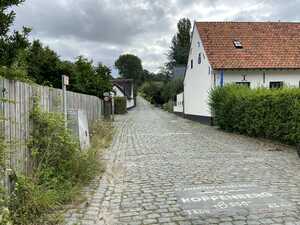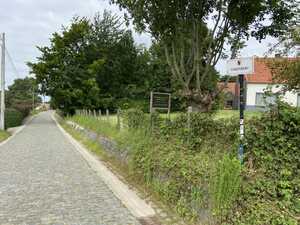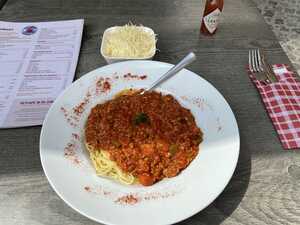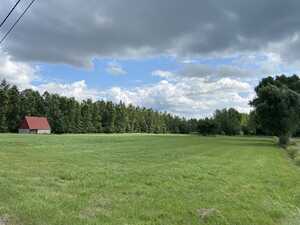
Flanders is truly the heartland of cycling. Its famous cobbled climbs have produced an almost bewildering number of cycling greats—from Eddy Merckx to Johan Museeuw, from Rik Van Looy to Roger De Vlaeminck. In the modern era, high-profile riders of the likes of Boonen, Van Avermaet, and van Aert all hail from this region.1 No other place in the world lives and breathes cycling to the same extent as this particular part of Belgium.
The Ronde van Vlaanderen, or the Tour of Flanders, is the region’s crown jewel. As one of the oldest and most prestigious races in the sport, the Ronde is an institution of cycling and is known colloquially as “Flanders’ Finest.” In particular, this race is known for passing through the cobblestone-paved hills of the Flemish countryside; the most famous of these hills, like the Kwaremont, are renowned the world over for their toughness. If the grand tours of cycling (e.g. the Tour de France) are about endurance and epic mountains, the cobbled classics (e.g. the Ronde) are about brutality over unforgiving terrain. Of course, I couldn’t resist making a trip to Belgium to test my mettle on these fearsome climbs.
The first issue was getting to Belgium in the first place. I was staying in Lille, France, which is actually quite close to the Belgian border. My original plan was to rent a bicycle in neighboring Roubaix and then simply ride across the border. However, this turned out to be harder than anticipated: I had some trouble finding a good bicycle rental in Roubaix.2 One company that I contacted told me that they wouldn’t be able to do it, but that there were lots of rentals in Oudenaarde, Belgium. So then my second plan formed: I would wake up at 5:00 am, take the train into Belgium in the morning, rent a bike for the day, ride around, return it, and then take the train back home at night. What could possibly go wrong?
Okay, the second issue that arose was that my prepaid SIM card, purchased at a French magazine store, could only be used in France. I usually use my phone to navigate when riding, so this was a bit of a problem. I ended up just downloading an offline map to use.
The third issue that arose was that I nearly missed my first train. My itinerary was to take a train from Lille, France to Kortrijk, Belgium, and then to take another train to Oudenaarde, Belgium. But as the departure time approached, I couldn’t find the train to Kortrijk; I desperately ran around the station, checking all the signs, but there was no train scheduled to leave for Kortrijk. However, there was a train scheduled to leave at exactly the same time, headed for Courtrai. It then dawned on me: my ticket had the Dutch name of the town (Kortrijk), but since I was in France, the schedule at the train station had the French name (Courtrai). I fortunately realized this just in time, and I got on before it left.
The next issue: my train from Kortrijk to Oudenaarde, a commuter train bound for Brussels, was delayed. I got on the train, and the departure time came…and went. There was some announcement in Dutch, but of course I couldn’t understand a word of it. Another passenger got off the train, but she later got back on, so I assumed that the train had just been delayed and would shortly depart. It did eventually leave, about twenty minutes behind schedule. I was a little bit worried, because there was some rain forecasted for later in the day, and I wanted to finish my ride before the rain started.
But eventually, after these issues were resolved, I made it into Oudenaarde. The town was quite quiet; the streets were fairly empty, probably since it was before 9:00 am on a Saturday. After a short walk through town, I arrived at the bike rental shop. I had previously made a reservation, so everything was quite smooth; the owner even let me leave my belongings at the shop while I went on my ride.
I started out on a riverfront trail near the bike shop and then wound my way through an industrial part of town, aiming to get out into the countryside. My plan was to stick near to Oudenaarde and tackle four of the famous cobbled climbs raced in the Ronde:
(These statistics were taken from Wikipedia, but you can find them all over the Internet.)
Of course, the Ronde also passes through other well-known climbs. Notably absent from this list is the Muur van Geraardsbergen, the so-called “Wall of Grammont.” Unfortunately, it’s a bit of a logistical nightmare to try to hit every famous hill, and where would you put the cutoff, anyway? Perhaps the Eikenberg should be included, but what about the Kanarieberg, or the Steenbeekdries? Without a local guide, trying to hit every single hill is an impossible task.
After riding on some highways, my route at last took me into the fields and small towns of the countryside, where the primitive cobbled roads lay.
It was when I saw the sign proclaiming “Oude Kwaremont, that way” that I knew that I had truly arrived in Flanders. Of the four climbs that I had planned, the Kwaremont is the least steep, but it makes up for it by also being by far the longest.

Then, the climb itself began. There’s a certain technique when it comes to riding over cobblestones—you want a loose grip on the handlebars and a strong but seated acceleration. I knew the theory, of course, but once you’re actually on the cobbles, all of that sort of goes out the window, and you just push forward however you can. All this while, your body is rattling wildly as your bike moves across the uneven surface, as if the bike were a misbehaving horse trying to throw off its rider.
When I thought I had reached the top, I got off to enjoy the view and take a bike picture. Seeing that this was a fairly remote area, I also went to pee by the side of the road, since, you know, I’m not a triathlete.3


I then passed a charming little Belgian village before continuing onward. I saw a funny sign marking the end of the climb. It was then that I realized that I had made a fatal mistake: I had actually not been done with the Kwaremont at all; I had been on it the whole time! I had urinated on one of the most important hills in all of cycling!
This was an unfortunate occurrence, but I was not about to ride back down the cobbles to do it again properly. Riding up cobbles is already bone-jarring enough; riding down is a bit too much for me. I decided to proceed on my route to the next hill instead, hanging my head in shame.

I did see some graffiti on the road with the initials of professional riders, a testament to the race some months before, when these roads were lined with cheering spectators. (I had watched this year’s Ronde from the comfort of my apartment in Pittsburgh.) “WVA” was written quite frequently, in support of the local hero Wout van Aert. I also saw some graffiti spelling out “MVDP,” evidently meant for the popular Dutch rider Mathieu van der Poel.
My climbing on the Kwaremont was rewarded with an incredible descent (on tarmac!), which was a great chance to recover and take in the pretty Flemish countryside. It turns out that this recovery was much needed, because the next thing on the menu was the mighty Paterberg.
This climb was similarly well-marked, with a big, helpful sign indicating the direction of the hill. I naturally made sure to get some pictures in front of the sign.


A few other cyclists passed me while I was taking pictures. They were also headed to the hill. The base of the climb was unassuming, but then it rapidly gets steeper. Caught unawares, I had forgotten to shift into the little ring, and I had to frantically smash my shifting lever. Luckily, my renal bike was equipped with a fairly reliable Shimano 105 groupset, and I managed to put it in the little ring. I nearly had to climb the Paterberg in the big ring, which would have been a disaster to say the least.
On paper, I’ve done steeper hills before; Rialto Street in Pittsburgh is similarly steep, and Canton Avenue is steeper. But nothing quite prepares you for the roughness of the Belgian cobblestones, where your wheels lose traction and you need to put as much power as you can into the pedals just to stay upright. The section in the middle felt mind-bogglingly steep, and I nearly came to a standstill.


The cyclist in front of me actually had to get off his bike and walk up the hill; once you get off the bike, the hill is far too steep to remount. I am proud to say that I reached the top without getting off! Granted, I did pause, gasping for breath, once I reached the top. But hey, anyone who claims not to be out-of-breath after the Paterberg is either lying or rode it downhill rather than uphill.
At the top, some local residents were getting out of their house. I wonder if they get tired of all the cyclists who must come here all the time.
When I got to the next hill, there was a small group of people gathered at the bottom. They were evidently not planning on making an attempt; they were wearing ordinary clothes and riding city bikes that would be inappropriate for this beast, but they had stopped to take pictures of it: the great Koppenberg. When I stopped to take a picture of the sign, one man asked me if I was going to ride it. Or at least that’s what I assumed he was asking; he spoke in Dutch. I told him that I didn’t speak Dutch but nodded and pointed up the hill.


The Koppenberg is almost certainly the most fearsome of the four climbs. It’s said that Eddy Merckx himself once had to walk his bike up this hill, and in one edition of the Ronde, only two riders managed to get to the top without stopping. Granted, they did it in far worse weather conditions than I did. Rain really makes the climb much harder—it’s already very hard to get any traction on the rough cobbles when they’re dry, much less when they’re coated in a slick film of mud. They also rode it before the road was resurfaced4 in the early 2000s.
But still, I think I can be proud that I made it to the top without stopping, despite the vigorous protests of my legs. To describe the climb itself is difficult…you cannot hold anything back at any point on the hill, or else you’ll fall over. It was a great struggle, and on the steepest pitch in the middle, I wasn’t sure if I had the strength to do it. The difficulty of the Koppenberg comes largely from its steepness and the poor condition of its cobbled road surface. If you have to stop at any point on the hill, it’s almost impossible to get back on the bike again.
Given the difficulty of dismounting, I obviously do not have any pictures of the climb itself. Just imagine a wall made of cobblestone, and you more or less have the right idea. Or you can look up a picture online; there are tons floating around. It actually feels somewhat similar to Canton Avenue in Pittsburgh: both are incredibly steep and cobbled, although the cobbles on Canton Avenue are much gentler than those in rural Belgium.

Anyway, after the Koppenberg there was some more lovely descending on paved roads, until I arrived at the next target: the Taaienberg.
It sounds strange to say, but after the ridiculous gradients of the Paterberg and the Koppenberg, the still-formidable Taaienberg came as sort of a relief. (Well, I didn’t think so when I was in the middle of the steepest pitch, at an eighteen percent gradient, so I guess the Taaienberg got the last laugh…) It’s a rather unassuming road, nestled among a grove of trees at a fork in the road. If not for the white line at the bottom of the hill marking the start, one might easily miss it.


Finishing the Taaienberg, the last of the four hills of the day, felt a bit anticlimactic. The hills are actually all very close together, so I hadn’t covered very much distance yet. The weather was holding, so having paid for the bike rental for the entire day, I decided to continue the ride.
Not having ridden up the Kwaremont in one go the first time around, I felt that I had to make amends by doing it again. I took a rather circuitous route back to the base of the climb and rode up. On the way, I saw a funny sign: at first, I thought that it said “Turing machines” and got very excited. I doubled back to read it again, but to my disappointment, it said “tuin machines” (apparently Dutch for “garden machines”).


This time, I went up the Kwaremont without stopping. I didn’t set a particularly fast time, but oh well.
The next thing on my agenda was to figure out my lunch plans. This was a rather rural region, so there weren’t many restaurants open. I could head back to town (i.e. to Oudenaarde), where there would surely be somewhere to eat. However, I didn’t want to terminate my ride so soon. I rode through a few small villages (really just clusters of buildings), but nothing stood out to me. I then had a bright idea: I had heard that there was a café in the village in the middle of the Kwaremont. What better place to enjoy a mid-ride lunch?
I rode to the small cluster of buildings in the middle of the hill and checked out the menu at the first little shop. The good thing: there was an English menu, evidently aimed at cycling tourists like me. The bad thing: the prices were quite astronomical. A salad cost more than twenty Euros! Being an undergraduate, this is not exactly my kind of place, so I thanked the owner and made a quick escape.
I then went to the next place down the road, but it turns out that everything was roughly the same price. Maybe Belgium is just an expensive country, or maybe these cafés mostly served tourists. After scanning the menu again, I found a simple pasta dish that was sixteen Euros. Reasoning that this was the best that I was going to get, I just ordered it.


The food was decent, but then again, I would expect a pasta that cost sixteen Euro to be pretty good at any restaurant! There were a couple of other people there, some of them also cyclists in lycra kit.
I gradually made my way back to Oudenaarde through a mix of small country roads and bike paths. In contrast to the steep hills that I had ridden earlier, this part of the ride was quite flat. I had been quite fortunate with the weather in the morning; the forecasted rain still hadn’t shown up, and there was even some sunshine to cheer me up.


I then got back to Oudenaarde, finishing my ride right about where I started it. It was early in the afternoon, and I had the bike for the rest of the day, so I decided to just wander around town on two wheels. Of course, I took an obligatory bike picture.

But then it finally happened: the rain started. It was only a light shower, and it would prove to be quite short-lived, but I am a bit fussy with the weather, and I decided that I would just return the rental bike early and spend the rest of the day exploring the town on foot. When I went to give back the bike, the shop owner seemed surprised that I had made it up the Koppenberg without putting my foot down; I had to explain that I had done it in the morning, before the rain.
Anyway, walking around Oudenaarde was pretty nice; while not particularly famous outside of cycling, the town has its fair share of attractive buildings.



There is a museum dedicated to the Ronde in the center of town. I went in, but there was an admission fee to see the gallery, so I didn’t go there. There was a little gift shop; I was mildly tempted by a cycling cap with “Flandrien” written on it, but I had already gotten myself a cycling cap in Paris, so I decided against it. Plus, Flandrien is a title that must be earned—a Flandrien is someone who relishes cold and wet conditions, taking advantage of them while other cyclists suffer in the rain. I had bailed at the first drop of rain, so I figured I probably wasn’t worthy of the title.
For dinner, I raided a couple of local grocery stores on the way back to the train station and bought some processed goods, including a baguette. I then got to the train station just in time before it started absolutely pouring. So this was where the forecasted storm had been waiting. I just took refuge under the station’s canopy while I waited for my train to arrive to whisk me back home.
On the way back, I got to help some other passengers! They asked me if we were at Kortrijk; I pointed at the sign saying “Oudenaarde” and told them that Kortrijk would be the next stop.
Riding the cobbles is certainly physically taxing. I now have blisters on my hands from gripping the handlebars as they violently vibrated over the rough road, and my rear end is rather sore. (Though maybe I’ve just grown a bit soft after not doing much riding recently.) It’s a little humbling to think about how much faster professional cyclists go on these same climbs, and they often ride them multiple times, at the end of a 200+ kilometer race, in adverse weather conditions.
Actually, I think that Pittsburgh is not dissimilar to Flanders: both don’t have any big mountains, but there are a ton of short, steep hills. I suppose the difference is that Pittsburgh is not nearly as famous as Flanders is when it comes to cycling. As someone who is into the sport and happened to be in the area, coming to Flanders felt well worth the trip, but if you just want steep hills, southwestern Pennsylvania will do just fine, even if it’s not as exotic.
Finally, I have to give a shout-out to the bovine buddies and equine esquires that I encountered in the countryside.5 Hah, you thought I had forgotten about them, but as I’ve said before on this blog, I can never pass by some farm animals without mentioning it.
As a side note, I’m not sure why the “v” in “Van Avermaet” is capitalized but the one in “van Aert” is not. This seems to be the consensus, so I’ll stick with it.↩︎
Funny story: every time I searched “bicycle rental Roubaix” online, I got back results for renting the Specialized Roubaix (a brand/model of bike named after the town) somewhere in the United States rather than actual bike rentals in the city of Roubaix. I eventually figured out that doing the search in French got me much better results.↩︎
For the uninitiated: there’s a friendly rivalry between road cyclists and triathletes. The former like to make fun of the latter for peeing in their pants during races. In all fairness, sometimes road cyclists will also pee in their pants, especially if it’s raining anyway.↩︎
Here, “resurfaced” means that they set the cobblestones in concrete. Allegedly this was done to prevent people from stealing the famous stones. The surface is still quite rough, but maybe not so much as before, and at any rate there isn’t as much loose dirt around now.↩︎
Sorry, it’s hard to think of nouns starting with the letter “e.” It was either esquires or earthlings.↩︎
Comments